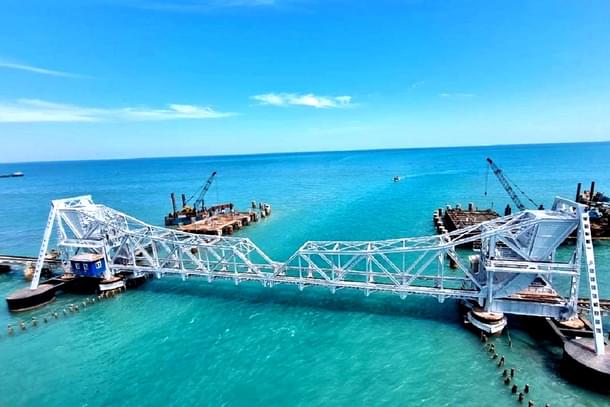News Brief
Lessons From Pamban Bridge: Proactive Safety Measures Introduced For Indian Railways' Bridge Designs
V Bhagya Subhashini
Jan 15, 2025, 03:13 PM | Updated Jan 17, 2025, 03:13 PM IST
Save & read from anywhere!
Bookmark stories for easy access on any device or the Swarajya app.


In a significant move to bolster the safety and efficiency of railway bridges, the Railway Board has directed all zones to involve the Commissioner of Railway Safety (CRS) during the design stage of major bridges.
This decision follows the Southern Circle Railway Safety Commissioner, A.M. Chowdhary's, investigation into the newly constructed Pamban Bridge, which revealed serious lapses in its planning and construction.
The new Pamban Bridge, India’s first vertical-lift rail bridge, connects the mainland to Rameswaram Island in Tamil Nadu. It serves as a critical rail link for the region. The bridge will be around 2.2 km long and will replace the existing century-old iconic structure built during British rule.
In November 2023, Chowdhary flagged several deficiencies in the project, including the absence of inputs from the Research Design and Standards Organisation (RDSO) and non-compliance with key construction norms. Despite these issues, the bridge was cleared for operation following necessary adjustments.
The Railway Board's new guidelines, issued on 10 January, emphasise proactive measures to ensure the seamless inspection and commissioning of major bridges. These include mandatory CRS consultations on special features or innovative elements of bridge designs during the early stages. The directive also requires railway zones to submit detailed applications to the CRS, including General Arrangement Drawings (GADs) and waterway adequacy calculations, before construction begins.
Under current protocols, a Design Basis Report (DBR) for significant bridges must be prepared and approved by the Chief Bridge Engineer and reviewed by RDSO. In cases where additional expertise is required, RDSO recommends forming a Technical Advisory Group (TAG).
The revised guidelines now mandate that the CRS be informed about TAG recommendations and any unique features of the DBR, ensuring better oversight, reports Economic Times.
This shift marks a departure from the earlier practice of involving the CRS only after a bridge’s completion, a process criticised for its reactive nature. A senior railway official explained that the new measures aim to identify and rectify potential flaws during the planning phase, preventing costly and time-consuming errors later.
The need for these changes became evident during the Pamban Bridge project, where the 72-meter vertical-lift span girder was designed without RDSO's input, and no TAG was formed. The lapses led to a review of railway bridge protocols. Railway Minister Ashwini Vaishnaw confirmed that the CRS was kept updated on the Pamban Bridge's progress, ultimately granting operational clearance.
V Bhagya Subhashini is a staff writer at Swarajya. She tracks infrastructure developments.




